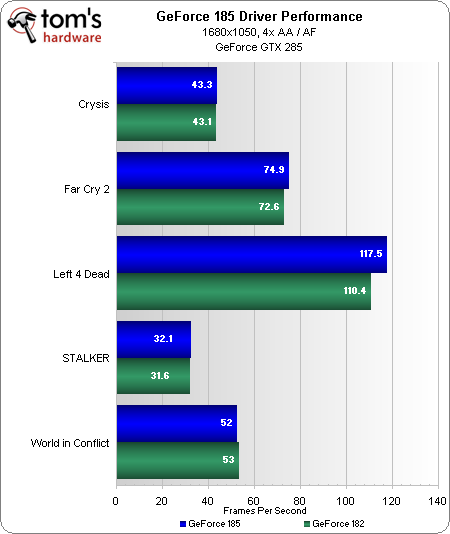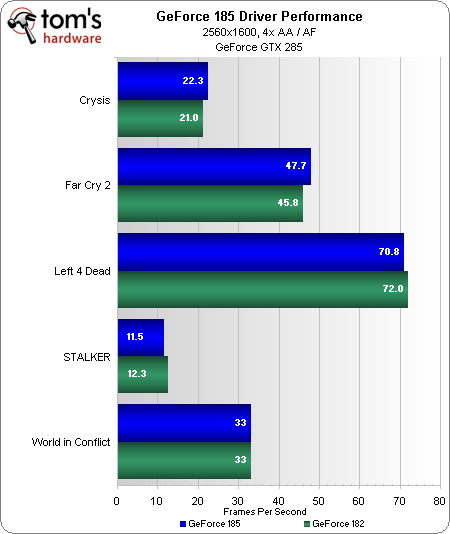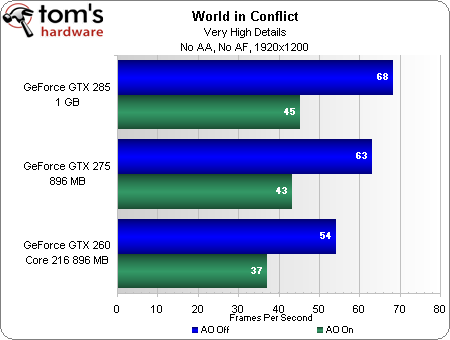Nvidia GeForce GTX 275 Preview: A Well-Timed Retaliatory Strike?
New Features In GeForce 185
As you flip through the benchmarks, you’ll notice that, in some cases, the GeForce GTX 275 comes pretty darn close to the GTX 285. This is partially due to a new driver used to test the GTX 275—Nvidia’s GeForce release 185. Nvidia says it improved the performance of its anti-aliasing compression, z-culling efficiency, and SLI scaling performance in certain game engines.
We tested currently-available cards using Nvidia’s latest GeForce 182 driver, but were forced to test the GeForce GTX 275 using the 185 build (similar to how we tested ATI’s Radeon HD 4890 with a beta build, but benchmarked the other boards using Catalyst 9.3). In order to give you a better idea of what GeForce 185 delivers on its own, we tested the GeForce GTX 285 at a couple of different settings across the entire benchmark suite using just the 185 driver.
There are a few notable performance deltas, but the changes aren’t massive in any one title, or even consistent, for that matter, from 1680x1050 to 2560x1600.
The new driver also adds support for ambient occlusion in games that don’t already include a control panel check-box for it. Ambient occlusion approximates the way light radiates in real life, thus adding shadows and shading in areas where they should be, but aren’t seen when the capability is lacking. There’s a fairly substantial performance hit when you turn on AO in Nvidia’s driver, so you'll need to decide for yourself if the compromise is worthwhile.
In a game like World in Conflict at 1920x1200 on a GeForce GTX 285, you have performance to spare. Turning AO on drops you to an average of 45 frames per second, but makes a noticeable difference in how the environment looks, as blades of grass occlude light and become much more distinct when you zoom in to the battlefield.
Get Tom's Hardware's best news and in-depth reviews, straight to your inbox.
Current page: New Features In GeForce 185
Prev Page Still Waiting On A Killer PhysX App? Next Page Test Setup And Benchmarks-
privardo This would be my good price, good performance and the right time upgrade from 8800 GTS 512mb. Thanks for this awesome review!Reply -
eklipz330 i think putting the competitors next to eachother would have been easier on the eyes... putting 4870x2 gtx295 next to eachother, 4890 gtx275 next to eachother...you catch my driftReply -
cangelini Yeah, but with each resolution its own color, after looking at it both ways, it was easier to put each product family in descending order--hopefully it makes just as much sense that way!Reply -
eklipz330 srry for dp butkudos to nvidia for stepping up their game in the last second that had nothing to do with renaming cards. an attractive card at an attractive price.Reply
it'd be smart for ati to not release the 4890x2. wouldn't make any sense, like my grammar skills. hopefully drivers can catch up and do some damage, id doubt they woudl do anything dramatic though. -
megamanx00 Too bad they didn't overclock the 4890 and the 275 for the review. I would have liked to have seen how the two cards compared overclocked. The heat and power dissipation on the 4890 would probably be a little scary though :D.Reply -
megamanx00 I think the big thing for nVidia now is, who's going to spend money on a 285 with the 275 so close?Reply -
cangelini megamanx00Too bad they didn't overclock the 4890 and the 275 for the review. I would have liked to have seen how the two cards compared overclocked. The heat and power dissipation on the 4890 would probably be a little scary though .Reply
No need to fuel the tin-foil brigade elsewhere on the Web re: hand-picked cards. When we can get our hands on these boards for our System Builder Marathons, straight from e-tail, then we'll give you the goods on overclocking with the same boards available to everyone else! -
privardo ReplyOriginally we said that the price would be $249 in the US, and €249 in Europe, however if the Euros-to-USD conversion is correct (1.00 Euro = 1.31 U.S. Dollars), the North American version should cost $327 instead.
If the retail price for this card is turn to be over $300, they will never fool this monkey cause he will just get two HD 4770 and crossfire'd them, which surely beat a single 275 -
privardo Reply"Originally we said that the price would be $249 in the US, and €249 in Europe, however if the Euros-to-USD conversion is correct (1.00 Euro = 1.31 U.S. Dollars), the North American version should cost $327 instead."
If the retail price for this card is turn to be over $300, they will never fool this monkey cause he will just get two HD 4770 and crossfire'd them, which surely beat a single 275 -
ifko_pifko Well... summing all the framerates is just nonsense. ;-) The games with higher fps will weigh more than the others. (I know that in this test the variance in fps is not as wide as in tests with more games, but keep that in mind in the future please and learn the basics of statistics... )Reply




